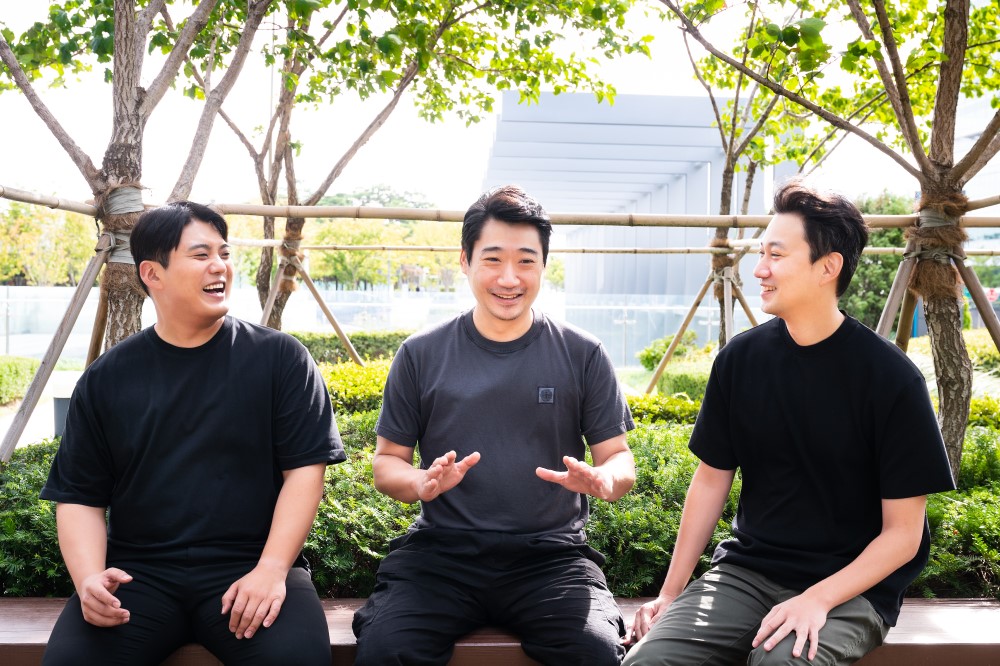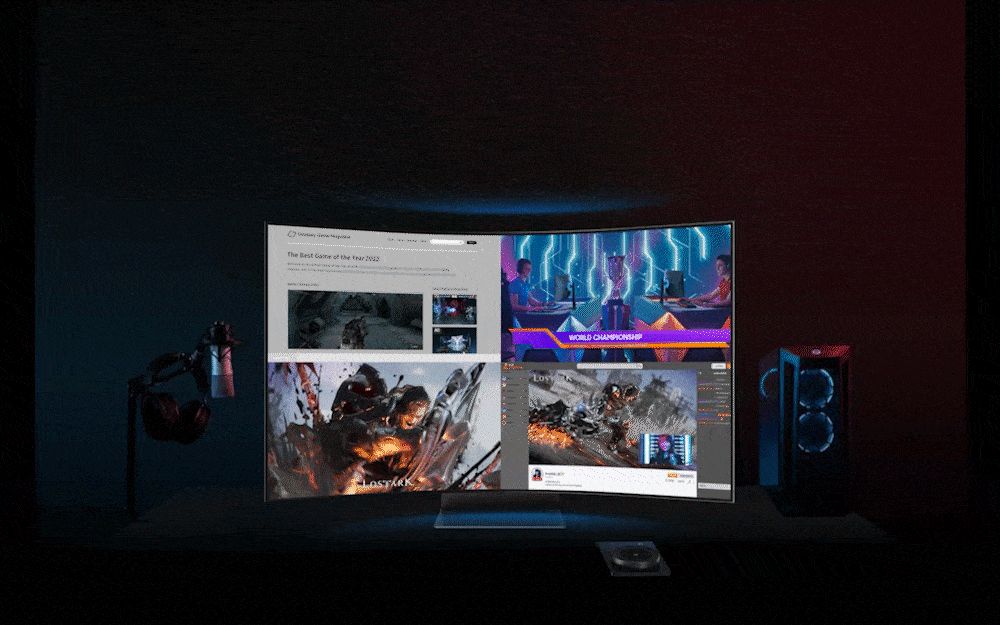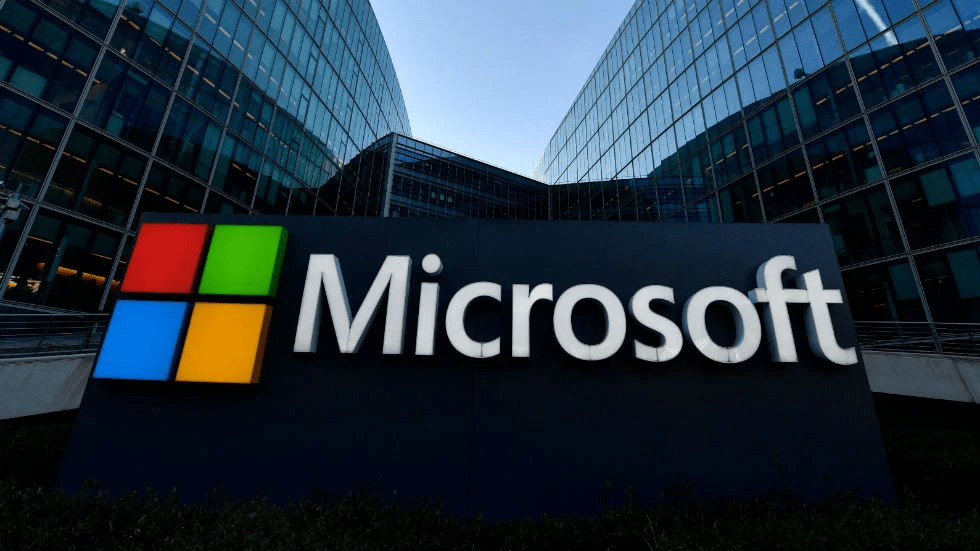Tech
Bringing the Odyssey Ark to Life: Meet the Team Behind the Groundbreaking Gaming Screen

In the game world, we can become captain of a warship or the world’s fastest racer. Gamers enter their own unique virtual space via a screen. Samsung Odyssey Ark, a 55-inch 1000R curved gaming screen, has introduced a new world for gamers.
How was this innovative gaming screen invented? To learn more about the entire development process from concept design to development and commercialization, Samsung Newsroom sat down with three experts who strived to create the masterpiece, Odyssey Ark: Hyun Mook Choi, who successfully turned his Odyssey Ark concept into the final product, Jisoo Kim, who worked on product design intended to give gamers the best gaming experience possible, and Kyuseong Lee, who designed various features to enhance game experience.
(From left to right) Kyuseong Lee in Future Planning Group, Jisoo Kim in Design team, Hyun Mook Choi in Future Planning Group of Samsung’s Visual Display Business
The Start of Odyssey Ark: Offer “A Unique Gaming Space Where Gamers Can Stand Out”

Along with vertical Cockpit Mode, Odyssey Ark, a 55-inch 1000R curved gaming screen, boasts an overwhelming presence. The completely new form factor came from the desire for space.
“I drafted the concept of Odyssey Ark thinking that everyone might have had a dream of creating their own arcade with their favourite game device.” Hyun Mook Choi, who first designed Odyssey Ark’s concept, recalled the time when he came up with the idea.
Jisoo Kim said the product design was inspired by his six-year-old boy making a fortress for his own space. He thought a flexible screen could satisfy gamers’ unique desire for their own space. They found common ground in space and refined the concept.
“In the early stages of design, we found through interviews that most game lovers wanted to have ‘a large screen that can wrap tightly around them,’” said Choi. “Gamers crave a special screen providing a great presence in their room and from that we set a goal of creating a product that gamers would want to show off.”

The difference of home gaming from home theater and home office is that it should offer “a fun escape from daily life” rather than blending in with it. “That is why we thought a rotating 55-inch 1000R curved gaming screen could mesmerize gamers with a completely different form factor,” said Kim. “Odyssey Ark was developed with a sophisticated and overwhelming design to make users feel that they can win with this gaming screen. Visual excitement was also added by allowing users to dynamically rotate the screen in any direction.”
“When devising the product plan, we paid attention to the fact that the gaming market is no longer about simply playing, but it has grown across the platform by absorbing every entertainment element, including visual aspects and increased interaction.” He proudly explained, “From the very beginning, Odyssey Ark was positioned as a ‘game changer’ to pioneer a new market.”
Built for Gaming! Back Story Behind Designing Convenient Features To Meet Individual Needs

Gamers have warmly welcomed Odyssey Ark because it seemed to read their mind. Kyuseong Lee, a gaming enthusiast and part of the Future Planning Group, joined the project and came up with ideas. “I first thought about what makes me feel uncomfortable during gameplay and made efforts to reflect the game pattern of players and their lifestyle types,” he said.


In combination with its incredible picture quality, the Odyssey Ark has become “a true gaming screen for gamers” with its analysis of gamers’ usage patterns and new gaming features, such as Flex Move Screen, Multi View and Ark Dial.
The most essential part in product development was the picture quality technology. “We adopted the same processor used in the best-quality Samsung TVs for gamers who spare no expense to play a game smoothly with incredible picture quality,” Lee said. Combined with 4K resolution, the huge display features amazing gaming specifications with a 165Hz refresh rate and 1ms response time (GtG).

Hyun Mook Choi, who designed Flex Move Screen, highlighted the purpose of product development saying, “Most gamers like multitasking, so they keep changing where to place the main monitor on their desk and adjust the screen size and ratio based on what to play.” Flex Move Screen allows users to choose a screen size between 55- and 27-inches, as well as the screen ratio between 16:9, 21:9 and 32:9. In addition, it also helps users find the most comfortable posture by adjusting its screen position within a large, 55-inch screen.

Ark Dial, the exclusive controller for the Odyssey Ark, was designed for gamers who continuously adjust settings to save time and find shortcuts. Users can easily change the screen layout and setting with Ark Dial as well as quickly and simply control Multi View. “The internal test shows that Ark Dial drastically reduces the setting time from about one minute to five seconds,” said Kim. “For the Ark Dial test, we even rented acquaintances’ luxury vehicles and tested how smoothly it rotates and response time of the jog dial.”
In addition, the Odyssey Ark introduces immersive sound with Dolby Atmos based on a 60W 2.2.2 channel and Sound Dome Tech. Choi got insight from reviews involving professional gamers, T1. “Contrary to our thoughts that all gamers would like to play a game wearing a headset, they prefer to use speakers. This clearly shows that a perfect sound direction and lifelike gaming sound effects are particularly important.” said Choi. “That is why the Odyssey Ark offers multi-channel speakers and additional woofer.”
Continuous Studies and Testing To Create Totally New Product Concept


Inventing a new product means continuous testing, experiments and studies. Moreover, strengthening the large screen’s usability on the desk was a daunting task. They adopted 1000R curvature to optimize the near-field viewing angle of the 55-inch display. A thin plate for the bottom part helps gamers efficiently use space even with the large screen.
Kim explored more than 500 videos on gaming room decorating and game-related documentaries to learn how gamers decorate and organize their space. “To develop a 55-inch 1000R curved gaming screen, I watched videos that carry gamers’ daily life and analyzed their lifestyle,” he said.
Then, they created product mockups by using a form board and viewed the screens with projectors to find the ideal screen size and curvature as well as to realize the ambition of vertical Cockpit Mode.
Lee conducted a two-week review involving heavy gamers in the U.S. and studied every detail of gamers’ needs regarding features and interfaces. “During the four-day business trip I had to deal with real-time issues and responses day and night. But it was such a meaningful time that I even forgot how tired I was!” Lee said.
Any new feature requires significant time and effort as many people from different departments work together to verify UX, GUI, compatibility with conventional features and quality control. “I think it is the first project in which so many people from different departments joined together for a single product,” said Choi. “It is incredible that every single person actively participated in the project.”
Odyssey Ark Is Finally Here. So, What’s Next?

The Odyssey Ark surprised the world with its amazing gaming screen. But when asked about the next plan, every expert uniformly said, “This is only the beginning.” Lee said, “The ark is in the early stages. We will continue to update the product by reflecting gamers’ preferences.” Kim added, “I would like to overcome physical limits and create a better screen.” Choi shared his ambition saying, “We will do everything possible to allow users to seamlessly immerse themselves in any game with the Ark.” Going forward, the Odyssey Ark will continue to open new possibilities for gamers.
Tech
Google Unveils AI-Powered Pixel 9 Lineup Ahead of Apple’s iPhone 16 Release
Google has launched its next generation of Pixel phones, setting the stage for a head-to-head competition with Apple as both tech giants aim to integrate more advanced artificial intelligence (AI) features into their flagship devices. The unveiling took place near Google’s Mountain View headquarters, marking an early debut for the Pixel 9 lineup, which is designed to showcase the latest advancements in AI technology.
The Pixel 9 series, although a minor player in global smartphone sales, is a crucial platform for Google to demonstrate the cutting-edge capabilities of its Android operating system. With AI at the core of its strategy, Google is positioning the Pixel 9 phones as vessels for the transformative potential of AI, a trend that is expected to revolutionize the way people interact with technology.
Rick Osterloh, Google’s senior vice president overseeing the Pixel phones, emphasized the company’s commitment to AI, stating, “We are obsessed with the idea that AI can make life easier and more productive for people.” This echoes the narrative Apple is likely to push when it unveils its iPhone 16, which is also expected to feature advanced AI capabilities.
The Pixel 9 lineup will be the first to fully integrate Google’s Gemini AI technology, designed to enhance user experience through more natural, conversational interactions. The Gemini assistant, which features 10 different human-like voices, can perform a wide array of tasks, particularly if users allow access to their emails and documents.
In an on-stage demonstration, the Gemini assistant showcased its ability to generate creative ideas and even analyze images, although it did experience some hiccups when asked to identify a concert poster for singer Sabrina Carpenter.
To support these AI-driven features, Google has equipped the Pixel 9 with a special chip that enables many AI processes to be handled directly on the device. This not only improves performance but also enhances user privacy and security by reducing the need to send data to remote servers.
Google’s aggressive push into AI with the Pixel 9 comes as Apple prepares to unveil its iPhone 16, which is expected to feature its own AI advancements. However, Google’s decision to offer a one-year free subscription to its advanced Gemini Assistant, valued at $240, may pressure Apple to reconsider any plans to charge for its AI services.
The standard Pixel 9 will be priced at $800, a $100 increase from last year, while the Pixel 9 Pro will range between $1,000 and $1,100, depending on the model. Google also announced the next iteration of its foldable Pixel phone, priced at $1,800.
In addition to the new Pixel phones, Google also revealed updates to its Pixel Watch and wireless earbuds, directly challenging Apple’s dominance in the wearable tech market. These products, like the Pixel 9, are designed to integrate seamlessly with Google’s AI-driven ecosystem.
Google’s event took place against the backdrop of a significant legal challenge, with a judge recently ruling that its search engine constitutes an illegal monopoly. This ruling could lead to further court proceedings that may force Google to make significant changes to its business practices, potentially impacting its Android software or other key components of its $2 trillion empire.
Despite these legal hurdles, Google is pressing forward with its vision of an AI-powered future, using its latest devices to showcase what it believes will be the next big leap in technology. As the battle for AI supremacy heats up, consumers can expect both Google and Apple to push the boundaries of what their devices can do, making the choice between them more compelling than ever.
News
Microsoft Outage Hits Payment Processors

When major payment processing systems have problems, the issues impact many critical systems that society depends on. In this article, we’ll explain the cause of the Microsoft outage and discuss the impact computer networking issues had on Canada. We’ll also examine whether or not Microsoft was at fault and what businesses can do to prevent further outages.
What Happened With the Microsoft Outage?
The outage with Microsoft’s Azure payment processor resulted from a buggy security update from an outside company, CrowdStrike. CrowdStrike offers information technology security services for many Microsoft Windows computers. The company’s software developers sent a new update out, but instead of patching up minor issues with the existing software, the code within conflicted with Windows and prevented computers from booting up. Users expecting to start their computers for a typical day were instead faced with the dreaded “Blue Screen of Death” error message.
So, how does this produce a problem and a payment processor issue? Many computers running payment processing, among many other kinds of software used for airlines, banks, retail, and other essential services, couldn’t start and were unable to let payments through. This is a catastrophic issue for companies that are heavily reliant upon the speed and ease of an electronic transaction.
In Canada, the outage impacted critical computer systems for air travel. Flights couldn’t be paid for and booked, which caused major problems for customers unable to make transactions while flights remained grounded. Travellers stuck waiting for flights to take off made their way over to the airports’ Starbucks and other vendors, only to discover unusually long lines due to payment issues. Even online gamblers looking to take their minds off the situation couldn’t take full advantage of one of the fastest payment options out there because of the outage.
Aside from payments, hospitals for major health systems had to use paper to complete important tasks like ordering lab work and getting meals to patients. Emergency dispatch lines were temporarily unable to function correctly while their computer systems were down.
How Was the Outage Fixed?
Thankfully, CrowdStrike fixed the problem on their end quickly, mostly via an additional reboot that allowed CrowdStrike to send over unflawed code. Unfortunately, for some business and private customers, rebooting wouldn’t be enough with command-line level adjustments needed for the operating system to run correctly.
The Good and Bad of Outages
First, we’re thankful that the outage was not caused by hackers accessing and stealing a mountain of personal data. A recent outage with an automotive software provider went on for much longer and ended much worse for software provider CDK, which likely paid an undisclosed sum north of $20 million to get data back and systems restored.
By some chance, Microsoft is reported to have experienced its own outage, and many information technology professionals blame Microsoft in part for their issues because of how their systems attempted to fix the problem by rebooting over and over again, though some of Microsoft’s PCs needed to warn users to make a change manually. Unfortunately, any computer that required manual intervention took longer to recover, as a knowledgeable person had to access each computer affected by the issue. In some cases, between dealing with several hours of backlogged tasks and slow recovery processes, some businesses took days, not hours, to get back online.
The outage brings up another major point in the cybersecurity and computer industry. CrowdStrike and Microsoft are both big companies in their respective fields. As a result, the effects of bad code spread much further than they could have if there were more competitors making security products or if there were more software companies making operating systems like Windows. While only 8 million computers were believed to be affected out of a much larger global network, those are essential computers for worldwide communication and payment processing. Perhaps companies should be putting their eggs in more than one basket?
The testing methods for the outage are unclear—did CrowdStrike test the routine software update enough to detect the potential for a major outage? Apparently not.
What Should Businesses Do Next?
Software like Microsoft Azure’s payment systems come from what information technology professionals call ‘the cloud.’ The software is remotely managed over the internet, meaning that the computer that runs the system is not physically present at the location. Unfortunately, this also means that an issue with the internet can take critical systems out of service.
Businesses ranging from major airlines and banks to mom-and-pop stores would be well served by backup systems at their locations. These don’t have to be as primitive as the old-fashioned credit-card carbon-copy slide, but there are options available with consistent service that don’t repeatedly rely on the same networks.
Conclusion
There were certainly challenging moments for Canadian businesses and emergency services during the CrowdStrike and Microsoft outage. As they scrambled to understand the problem and waited, albeit briefly, for issues to resolve, many companies learned the importance of having local and reliable backup for their computer systems.
Tech
New photos reveal more details about Google’s Pixel 9 Pro Fold

Google’s secret new line of Pixel 9 phones isn’t that big of a secret anymore. Taiwan’s National Communications Commission (NCC) released new photos of the phones including the Pixel 9 Pro Fold from almost every conceivable angle.
Android Authority found the photos in the NCC archives and uploaded galleries of each of the four phones including the Pixel 9, 9 Pro, 9 Pro XL and 9 Pro Fold. They reveal some interesting details about the new Pixel phones.
The charging rates will be a little faster than the last generation of Pixel phones: Taiwanese authorities measured 24.12W for the base model, 25.20W for the Pro and 32.67W for the 9 Pro XL. The Pixel 9 Pro Fold, however, was the slowest of all of them at 20.25W. These numbers don’t often match up perfectly with the advertised ratings, so expect Google to be promoting higher numbers at its event.
Speaking of chargers, it looks like Google needed a bigger charger to power its new phones. Photos included in the NCC leak show each phone will come with a wall charger that’s around 45W depending on which model you purchase. The charger’s plug moved from the middle to the top of the brick.
The latest photo dump also shows the 9 Pro Fold unfolded for the first time. Google has moved the selfie camera to the inside screen for a wider field of view. The 9 Pro Fold also has a slimmer top and bottom, a reduced fold crease on the display and a full 180 degree unfolding angle to make a screen that’s just over 250mm or just under 10 inches.
These photos are the latest in a very long list of leaks of Google Pixel 9 photos. The last Pixel 9 leak came down yesterday showing two prototype models of the base and XL models. Google might look into buying a new combination lock for the high school locker where they apparently keep all their unreleased gear.

-

 News20 hours ago
News20 hours agoCalgary official compares strain on water system to revving car’s engine for too long
-

 Politics23 hours ago
Politics23 hours agoBloc Québécois ready to extract gains for Quebec in exchange for supporting Liberals
-
Health11 hours ago
Clickbank Nourished Mamas Guide to Postpartum | Birth Education Class in Holland
-

 News18 hours ago
News18 hours agoMediation aimed at resolving Metro Vancouver accessible transit strike underway
-

 News8 hours ago
News8 hours agoCanadaNewsMedia news September 9, 2024: Liberal caucus gathers for retreat in Nanaimo
-

 News10 hours ago
News10 hours agoCanadian Medical Association calls for more tracking of health care funds
-

 Business13 hours ago
Business13 hours agoTatiana Tarot – Make Money Online Reading Tarot
-

 News13 hours ago
News13 hours agoMediated talks aimed at resolving Metro Vancouver accessible transit strike stall

















